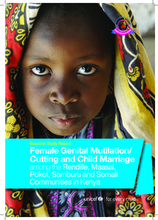Executive summary
In line with the 1997 interagency statement, Eliminating Female Genital Mutilation (WHO et al., 2008), the United Nations Population Fund (UNFPA) and United Nations Children’s Fund (UNICEF) launched a joint programme in 2007 entitled Female Genital Mutilation/ Cutting: Accelerating Change, with the objective of contributing to the accelerated abandonment of female genital mutilation/cutting (FGM/C) in one generation, with demonstrated success in 17 countries in Africa by 2012. The programme seeks to contribute to the overall goal, set by the 1997 interagency statement and reaffirmed by the 2012 United Nations General Assembly (UNGA) Resolution (UNGA, 2012), to intensify global efforts to eliminate FGM/C.
In Kenya, the joint programme was launched in 2008 in a collaborative effort with the Ministry of Gender, Children and Social Development and various non-governmental organizations (NGOs). Phase I, which ended in 2014, focused on the districts of Tana River, Garissa, Isiolo, Marsabit, Marakwet, Kuria, Migori, Naivasha and Mount Elgon, and achieved impressive results, with the formulation of a national policy on the abandonment of FGM/C, enactment of the Anti-FGM Act 2011 and upscaling of community-led actions against FGM/C and child marriage practices.
Analysis of data from over 70 nationally representative household surveys undertaken in the 29 countries where FGM/C is concentrated (UNICEF, 2013) shows that its continued practice is due to the perception of FGM/C as a social obligation, intertwined with tradition and religion. However, the data indicates that in many countries, prevalence has decreased, and across the majority of countries, including some of the high-prevalence countries, support for FGM/C is declining and the majority of the population wants the practice to end.
In the light of knowledge gained during phase I, including research and programmes supported by UNFPA, UNICEF and their partners, and based on the recommendations stemming from the evaluation of phase I (UNFPA–UNICEF, 2014), phase II of the joint programme was launched in 2014 and will run until 2017 in line with the strategic plans of UNICEF and UNFPA (UNFPA–UNICEF, 2016).
Phase II focuses on strengthening the enabling environment and increasing the demand side. The programme advocates and supports enforcement of the legal and policy framework, including standardising jointly developed guidelines relating to FGM/C. Additionally, the programme will focus on strengthening coordination between actors at a national level. Furthermore, the programme will continue to work with communities, focusing on children in and out of schools, and identify and train community change agents to hold community dialogues that are expected to contribute towards public declarations on the abandonment of FGM/C.
It is against this background that UNICEF Kenya commissioned a baseline study on FGM/C and child marriage among the Rendille, Maasai, Pokot, Samburu and Somali communities in Kenya. The main objectives were to establish the prevalence of FGM/C and child marriage among five ethnic communities in the following six study locations: Garissa (Balambala); Wajir South (Habaswein); Kajiado Central; Marsabit (Laisamis); Samburu (Wamba); and West Pokot (Sook).
The bases of selection for assessment of these communities, together with the target age cohorts of girls and women aged 10–49 and boys and men aged 15–49, were that: all the target communities have high FGM/C and child marriage prevalence rates in Kenya and are pastoral communities with low levels of education, especially among girls; the target areas were the new locations selected for FGM/C and child marriage interventions in 2014–2017; and the selected communities share traditions, cultures and borders with neighbouring countries including Tanzania (Maasai), Somalia (Somali), Ethiopia (Rendille) and Uganda (Pokot).
The study was conducted between December 2016 and March 2017 and adopted a mixed-method approach entailing desk review, and quantitative and qualitative design. In drawing up the sample for the quantitative design, random and systematic sampling was adopted. Out of a target total sample of 6,100 household interviews, 6,648 interviews comprising 1,357 boys and men aged 15–49 and 5,291 girls and women age 10–49 were successfully completed. In addition, a total of 133 interviews out of a total target of 250 were successfully completed with border communities. The qualitative design entailed use of focus group discussions (FGDs) and key informant interviews (KIIs) and adopted a purposive sampling approach due to the need for targeted and relevant interviews. All the targeted 24 FGDs were successfully conducted and 60 of the targeted 71 KIIs were successfully conducted.
During fieldwork, the study team visited Kajiado Central, Balambala, Habaswein, Laisamis, Sook and Wamba and interviewed community members and a broad range of key informants drawn from county and national governments, community-based organizations, NGOs, faith-based organizations and community leaders.
It is expected that the study findings presented in this report will provide the basis of interventions in the target sub-counties and divisions towards ensuring accelerated abandonment of the twin practices of FGM/C and child marriage.

